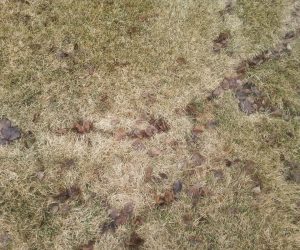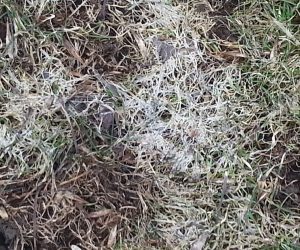Turf Talk!
Early Summer Turf Talk!
The weather this spring has been another great one for lawns in our Midwest area. The cool temperatures and timely rainfall during the months of April and May probably delayed the family pool opening, but your lawn has never looked better. Cool Season Grasses such as your bluegrass lawns have thrived in these conditions. As your lawn greens up, damaged areas begin stand out. These areas may be old disease scars, (those brown circles with the green center that may form during the summer), or old drought damage. If the damaged area is small, sometimes just raking that spot will be enough for recovery. Raking damaged areas removes old thatch and allows air and water movement that aids recovery. Larger damaged areas will need over seeding and top dressing with top soil. Good soil and seed contact is needed for seed germination. Don’t throw the seed on top of hard soil. You have to work the seed into the soil to a depth of ½ inch. Keeping the area moist until the seed sprouts is equally important. Remember, a bluegrass blend of seed for open sunny areas, and a mixture of blue, rye, and fine fescue for shady areas.
Every spring we get a few calls from customers wondering if we are applying our spring application too late. Please understand that there is a generous time frame to get our fertilizer and crabgrass control applied to your lawn. We start applying applications in March when the weather allows us to do so. This year, because of the late snow melt, our first applications were not applied until almost April! Spring applications always continue into the month of May. This gives us and other lawn care companies a window period to get our applications down before crabgrass germination. Not everyone will be done at the same. If you see other companies in your area before we get there, that doesn’t mean we are late. It means that all lawn care companies do not go into the same area at the same time. Sometimes we do. What you can be sure of is that Landscape Associates will apply your application in a proper, professional, and timely fashion.
Grub Worms
Now is the time to be thinking about having a Grub Preventive application applied to your lawn. Grubs are insects that feed on the roots of your lawn. The Grub Preventive application will apply a barrier of insecticide that will last until the time that the grubs are actively feeding on the roots of your lawn. Approximately late August – Early September. If you would like to add this application to your program, please call our office.
Mowing
It is all right to mow your lawn after today’s application if you do not have a lot of weeds. If there are a lot of weeds in the lawn wait 24 hours before mowing.By now the lawn should be at 2 1/2” – 3” of cutting height for the summer. To check the cutting height, measure from the ground to the bottom edge of the mower on the side. During the warmer periods, it is advisable to cut late in the day to reduce the loss of water within the plant. If your lawn is dry, watering it a day or two before cutting will help reduce stress. Never cut midday. This can cause undue stress to the lawn and enhance possible disease problems or force the lawn to turn brown. If you mow your lawn when it is in stress or dried out, you can actually burn the lawn. We have seen several cases where you can see the brown lines from the wheels of the mower. If possible cut in different directions so you do not groove tracks from the mower and this will help the grass stand up. A reminder about mulching grass clippings. By keeping up good mowing habits, there is no need to bag clippings as it does feed nutrients back into the lawn. Do not be concerned with thatch buildup from mulching, approximately 98% of the clippings decompose. Don’t forget to check your mower blade for sharpness.
Watering
There has always been a difference of opinion as to what time of day to water. The best time is early morning before 11:00 a.m. If you do not have the ability to do it then, the next best time is early evening. Now the next question is how much to put down and how often. Ideally try to water 1 -1 1/2 hours per area once every 4-6 days. Try not to water the whole lawn in a day, unless you have an underground sprinkler system. Moving hoses is time consuming and you don’t want to be a slave to your lawn. Try watering half the lawn one day, then the rest a day or two later.
Disease Activities
Proper watering and mowing are major factors on whether disease activity will start. There are going to be problems occasionally during the summer due to the high temperatures and humidity. If any activity does start, call us and we will advise on what to do.
Office Hours
Our office hours are Monday – Friday 8:00 a.m. to 5:00 p.m. Please remember that our answering machine is on 24 hours, 7 days a week, so do not hang up. If we are not in, leave a message and we will get back to you as soon as possible.
Your friends at Landscape Associates
Spring Turf Talk!
Hi folks! It’s safe to say that March did indeed come in like a lion. The huge snowfall amounts we have been getting all winter never had a chance to melt off until late March. As the spring thaw reveals your lawn under those piles of snow, you may notice how matted down the turf is. If the matted turf takes on a white-gray appearance, it is most likely snow mold. This is a common problem we see in the spring following a winter with heavy snowfall amounts. You may also notice brown tracks shooting out into your lawn from your shrub beds, from under your deck or patio, or in drainage and ditch areas. This is the sign of mouse or vole activity. The snow insulates their nests as they move out into your lawn from under the snow causing those tracks in your grass. Both matted down turf and mouse/vole damage will need your immediate attention as you begin your yard spring cleanup. Rake out these areas to allow better air movement for turf recovery.


Snow Mold – Picture 1 Mouse/Vole Damage – Picture 2
The Spring Lawn Application applied today contains slow-timed released nitrogen and crabgrass control. We have a large window period to get this application down because crabgrass will not germinate until sometime in June. You may notice wide bladed grasses in your lawn right now. This is either tall fescue or quack grass. These two are often mistaken for crabgrass. They are part of the perennial grass family (like bluegrass), and cannot be controlled like crabgrass, which is a summer annual. If broadleaf weeds, such as dandelions become a problem before our next visit, do not hesitate to call. We will respond to all service calls.
Mowing
In early spring, the sooner the lawn is cut, the faster it will respond to sunlight and warm soil temperatures. Try to get out in late March or early April to lightly rake out any matted down areas or debris left over from the winter. If possible, give the lawn a cutting to remove brown winter top growth. Removal of this top growth will aid your lawn to green-up faster. This will not start the lawn growing, so do not worry about having to cut it every week at this point. Your lawn will not start growing until soil and air temperatures reach a consistent fifty degrees. After your first cutting, raise the mower height to 3″ and leave it there for the remainder of the season. On most mowers this means setting the wheels down as far as they can go. You can check your cutting height by measuring from the ground to the bottom of the mower deck. When we say 3″ cutting height, we are saying that is how tall your grass should be standing after it is cut. Remember that you want to have this high mowing height set prior to hot summer temperatures. High cutting heights are needed for the grass plants to store water and nutrients which turn into carbohydrates. During warm-dry periods, the more carbohydrates reserved the better. Don’t wait for the hot weather and then raise your mower, by then it is too late. One last note – make sure that your mower blade is sharp.
Watering
During the spring there should be sufficient rainfall to aid the grass to its full potential. However, there have been times when we do not receive enough rainfall, and watering will be needed. It is important that your lawn does not dry out too badly during the spring because this is the time for new grass plants to fill in those thin areas, as well as extending their root system. Approximately 1” of water per week is sufficient if there is no rainfall.
Core Aeration
Several universities have done studies that show core aeration, done on an annual basis, will greatly improve air movement in the soil, water uptake, and will stimulate deeper root development in compacted clay soils. Core aeration can be done during the spring or fall as long as there is adequate soil moisture.
Seeding in spring
For best results, loosen the soil to a depth of 2”, and then incorporate the seed into the soil. If necessary, add some topsoil to level it out. Use a bluegrass blend of seed for the sunny areas of your lawn. Fine fescue and red fescue seed work best in the shady areas. It is very important to keep the upper layer of soil moist for best results. Remember, with newly seeded areas, you have to water lightly and often. The best time to seed is usually mid-late April. This is when the chances of frost are minimal. Germination takes approximately 14 to 21 days, so be patient.
Office Hours
Our phones will be answered from 8:00am to 5:00pm Monday thru Friday. If for some reason we cannot answer your call personally, our voice mail is on 24 hours a day. Please leave us a message and we will get back to you as soon as possible.
We now accept Visa, MasterCard, Discover and American Express. Call our office for details.
708 479 4600
